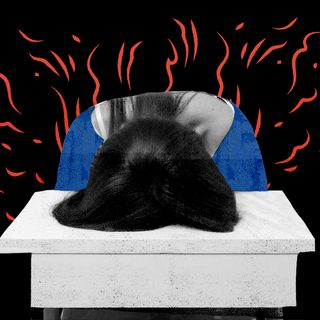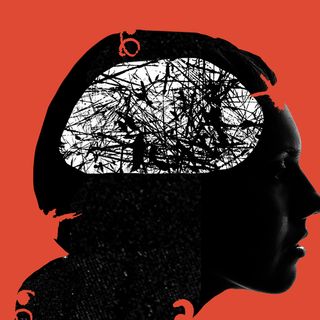
Ovulation Cramps Aren’t Discussed as Often as Menstrual Cramps. Are They Normal?
Ovulation cramps can not only be perfectly normal, but there’s even a name for them in German: “mittelschmerz,” or middle pain.

The experience of living through the pandemic — irrespective of whether or not one contracted the virus — triggered a host of changes in many individuals’ menstrual cycles. For some, “wonky” (but not unsafe) periods — including greater pain, heavier flow, and longer periods — were associated with the Covid19 vaccines, too. For others yet, it was the infection itself that induced irregularities in the way they experienced their periods. I was among the last lot, and since getting infected last year, have been experiencing excruciatingly painful cramps during ovulation. When I looked up ovulation cramps online, I found that depending on the severity, they could be perfectly normal. In fact, there’s even a name for it in German: “mittelschmerz,” or middle pain.
“The pain could be related to the ovarian follicle stretching your ovary before it bursts, or from the blood or fluid that is released from the follicle that irritates the lining of your abdomen or pelvis and causes pain,” Dr. Katharine O’Connell White, an associate professor of obstetrics and gynecology at Boston Medical Center, notes. “It’s unclear if the pain occurs at the very moment an egg is released, or if it occurs sometime before or after.”
Evidently, ovulation pain isn’t an isolated, abnormal experience. But strangely, we don’t talk nearly as much about ovulation cramps — in pop culture, in women’s health editorials, and on social media — nearly as much as we talk about the cramps people experience during their periods. It could be due to a multitude of factors. “Pain related to ovulation varies [from] woman to woman and cycle to cycle. There are many women who don’t experience any pain with ovulation, while others are bedridden from the pain,” says Dr. Sherry Ross, an obstetrician and gynecologist. It is likely, then, that the experience of menstrual pain being relatively more universal, it warrants more conversations, memes, and of course, more sexist humor.
In any case, ovulation cramps — like sex itself — is rarely spoken about, resulting in rather dismal awareness around the subject. As a result, sometimes, people mistake it for indigestion — setting off the vicious cycle where ovulation cramps aren’t acknowledged for what they are, and so, remain under-discussed. Among people who don’t track their menstrual cycles — let alone track its different stages — the inconsistency of ovulation cramps, too, might make it challenging to recognize. As Dr. White says, “Ovulation pain is not reliable; people who get this pain may not get it every month.” The lack of a clear pattern, then, can throw one off.
Related on The Swaddle:
Can Mental Illnesses Make PMS Worse?
With greater awareness, things could, however, be different. “It’s easy to recognize ovulation pain because it has a number of symptoms that are different from menstrual cramps… You’ll feel it only on one side of your lower abdomen, depending on which ovary is releasing an egg,” explains Dr. Amy Autry, an obstetrician and gynecologist, who believes around 20% of menstruating individuals experience ovulation cramps.
The pain can switch sides across cycles, and cause bloating. More often than not, it feels like a sharp pain or a sudden twinge, but can also manifest as a dull ache. Experiencing more intense pain can cause people to be nauseated, too. For some, the pain lasts a few hours; for others, it can last up to a day or even two days. “But in the vast majority of cases, abdominal pain or cramping in the middle of the menstrual cycle simply means that you’re ovulating and the pain will disappear soon,” Dr. Autry adds.
Experts don’t think the degree — or even the very presence — of ovulation cramps impact fertility, in any way whatsoever. Experiencing mittelschmerz doesn’t indicate that one is more fertile, compared to the general population, either.
Having said that, it is pertinent to note that if one is experiencing pain so intense that it interferes with their life, induces diarrhea, dizziness, fever, and chills, and causes them to struggle even with breathing, it is advisable to reach out to a medical professional. It could turn out to be normal; it’s also a common experience for individuals living with IBS and IBD. But it could also point to underlying health conditions like ovarian cysts, PCOS, pelvic inflammatory disease, appendicitis, or even endometriosis.
A commonly recommended solution is to use heating pads, or pop over-the-counter pain medication. If those don’t work, a birth control pill might — except, it could stop the process of ovulation itself, rather than making it painless. But if the pain is so bad that even painkillers aren’t working, it’s better to consult a doctor, rather than popping anything else. “If you experience disruptive pain associated with ovulation… it’s best to contact your healthcare provider and talk about your symptoms… The birth control pill can be helpful in preventing ovulation, thus preventing pain associated with this mid-cycle phenomenon,” Dr. Ross advises.
Devrupa Rakshit is an Associate Editor at The Swaddle. She is a lawyer by education, a poet by accident, a painter by shaukh, and autistic by birth. You can find her on Instagram @devruparakshit.
Related


Can Mental Illnesses Make PMS Worse?
